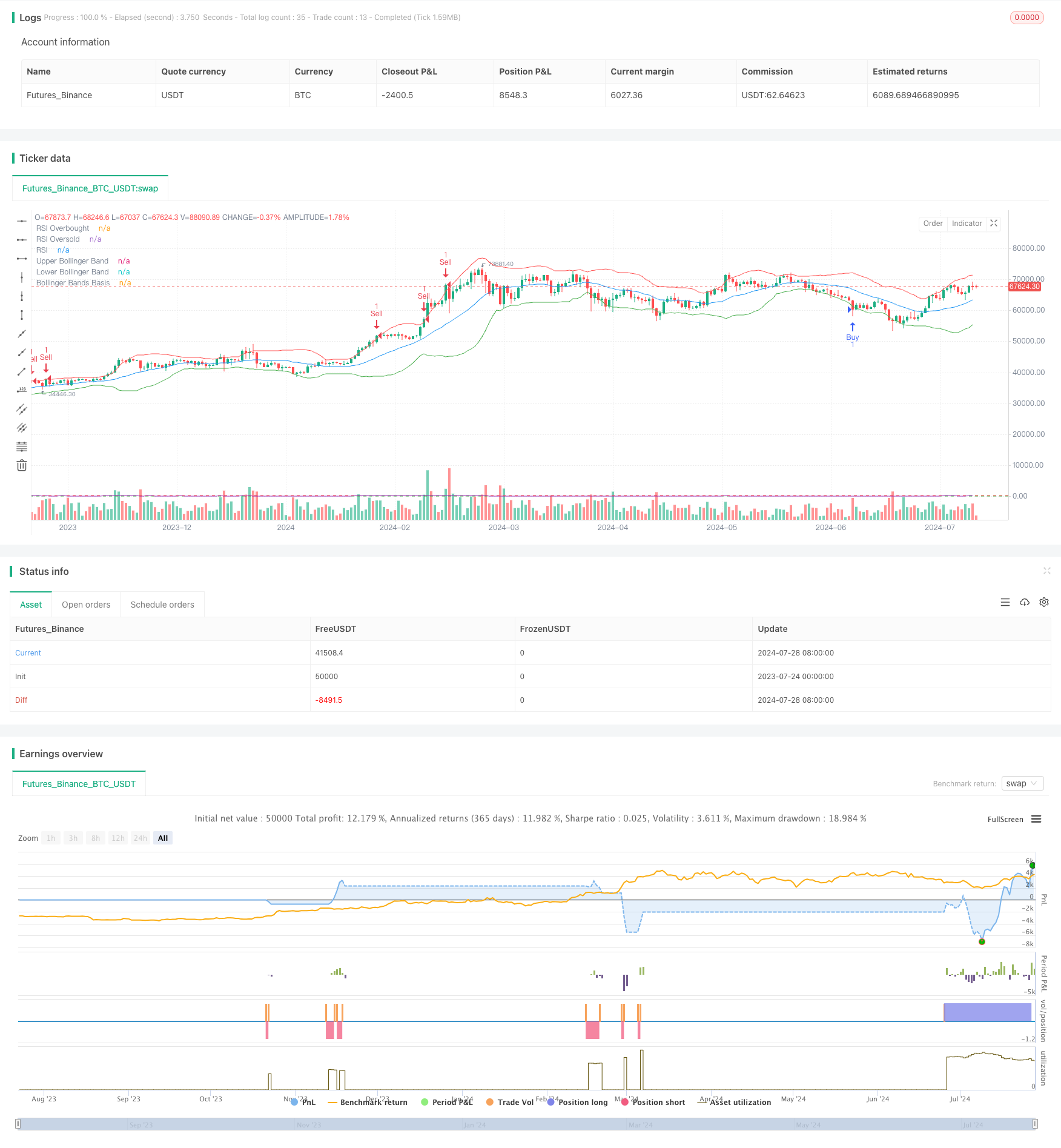
概述
本文介绍了一种基于布林带和相对强弱指标(RSI)的中性市场量化交易策略。该策略旨在利用价格波动和动量指标的组合来识别潜在的超买和超卖机会,从而在市场保持中性趋势的情况下进行交易。策略的核心思想是在价格触及布林带下轨且RSI处于超卖区域时买入,在价格触及布林带上轨且RSI处于超买区域时卖出。通过结合这两个技术指标,策略试图在市场波动中捕捉短期反转机会,同时通过设置止损和止盈来管理风险。
策略原理
该策略的核心原理基于以下几个关键组成部分:
布林带(Bollinger Bands):
- 使用20周期的简单移动平均线(SMA)作为中轨。
- 上下轨分别为中轨加减2倍标准差。
- 布林带用于衡量价格相对于其近期波动范围的位置。
相对强弱指标(RSI):
- 使用14周期RSI。
- 设定70为超买阈值,30为超卖阈值。
- RSI用于衡量价格动量和潜在的超买超卖状态。
交易信号:
- 买入信号:价格下穿布林带下轨且RSI低于30。
- 卖出信号:价格上穿布林带上轨且RSI高于70。
风险管理:
- 使用百分比止损(默认2%)和止盈(默认4%)来管理每笔交易的风险和收益。
策略的逻辑是,当价格触及布林带下轨时,通常表示价格相对于近期范围处于低位,而RSI低于30则进一步确认了超卖状态。这种情况下,价格往往有反弹的倾向。相反,当价格触及布林带上轨且RSI高于70时,表示价格可能已被高估,存在回落的可能性。
策略优势
多指标协同:结合布林带和RSI可以提供更可靠的交易信号,减少虚假突破带来的风险。
适应市场波动:布林带会根据市场波动性自动调整宽度,使策略能够适应不同的市场环境。
风险管理集成:内置的止损和止盈机制有助于控制每笔交易的风险,保护资金安全。
中性市场适用:该策略特别适合横盘或者趋势不明显的市场环境,可以捕捉短期的价格波动。
客观性强:基于明确的技术指标和数学计算,减少了主观判断带来的偏差。
易于实现自动化:策略逻辑清晰,便于编程实现和回测优化。
策略风险
假突破风险:在剧烈波动的市场中,可能会出现频繁的假突破,导致过多的交易和手续费损失。
趋势市场表现欠佳:在强劲的单向趋势市场中,该策略可能会频繁被止损,错过大趋势。
参数敏感性:布林带和RSI的参数设置对策略性能影响较大,不同市场可能需要不同的参数设置。
滑点和流动性风险:在流动性较差的市场中,实际成交价可能与信号价格有较大偏差。
过度交易风险:在波动剧烈的市场中,可能会产生过多的交易信号,增加交易成本。
系统性风险:完全依赖技术指标可能忽视基本面因素,在重大事件发生时可能遭受损失。
策略优化方向
动态参数调整:可以考虑根据市场波动性动态调整布林带和RSI的参数,以适应不同的市场环境。
增加过滤条件:引入额外的技术指标或市场情绪指标,如成交量、波动率指标等,以提高信号的可靠性。
时间框架优化:尝试在不同的时间框架上应用策略,找出最佳的交易周期。
止损止盈优化:可以考虑使用动态止损止盈,如跟踪止损或基于ATR的止损设置,以更好地适应市场波动。
加入趋势过滤:引入长期趋势指标,如长周期移动平均线,在强趋势市场中减少逆势交易。
风险管理增强:实现每日或每周的最大亏损限制,防止连续亏损导致的资金大幅回撤。
市场状态分类:开发一个市场状态分类模型,在不同的市场状态(如趋势、震荡、高波动等)下使用不同的策略参数或交易逻辑。
机器学习优化:利用机器学习算法对历史数据进行分析,自动优化策略参数或生成新的交易规则。
总结
布林带RSI中性市场量化交易策略是一种结合价格波动和动量指标的中性市场交易方法。通过利用布林带的价格通道和RSI的动量信息,该策略旨在捕捉市场的短期反转机会。其优势在于多指标协同、适应市场波动、风险管理集成以及客观性强,特别适合在震荡市场中应用。然而,该策略也面临假突破、趋势市场表现欠佳、参数敏感性等风险。
为了进一步提高策略的稳健性和盈利能力,可以考虑从动态参数调整、增加过滤条件、时间框架优化、止损止盈优化、加入趋势过滤等方面进行优化。同时,引入机器学习技术和市场状态分类模型可能会带来更大的突破。
总的来说,这是一个具有潜力的中性市场交易策略,通过持续的优化和风险管理,有望在各种市场环境下实现稳定的表现。然而,投资者在使用此策略时仍需谨慎,充分了解其局限性,并结合自身的风险承受能力和投资目标进行适当的调整和应用。
/*backtest
start: 2023-07-24 00:00:00
end: 2024-07-29 00:00:00
period: 1d
basePeriod: 1h
exchanges: [{"eid":"Futures_Binance","currency":"BTC_USDT"}]
*/
//@version=5
strategy("Neutral Market Strategy with Bollinger Bands and RSI", overlay=true)
// Input Parameters
bbLength = input.int(20, title="Bollinger Bands Length")
bbMultiplier = input.float(2.0, title="Bollinger Bands Multiplier")
rsiLength = input.int(14, title="RSI Length")
rsiOverbought = input.int(70, title="RSI Overbought Level")
rsiOversold = input.int(30, title="RSI Oversold Level")
// Calculate Bollinger Bands
basis = ta.sma(close, bbLength)
dev = bbMultiplier * ta.stdev(close, bbLength)
upperBB = basis + dev
lowerBB = basis - dev
// Calculate RSI
rsi = ta.rsi(close, rsiLength)
// Plot Bollinger Bands
plot(upperBB, title="Upper Bollinger Band", color=color.red)
plot(lowerBB, title="Lower Bollinger Band", color=color.green)
plot(basis, title="Bollinger Bands Basis", color=color.blue)
// Plot RSI
hline(rsiOverbought, "RSI Overbought", color=color.red)
hline(rsiOversold, "RSI Oversold", color=color.green)
plot(rsi, title="RSI", color=color.purple)
// Define Conditions
buyCondition = ta.crossunder(close, lowerBB) and rsi < rsiOversold
sellCondition = ta.crossover(close, upperBB) and rsi > rsiOverbought
// Entry and Exit Signals
if (buyCondition)
strategy.entry("Buy", strategy.long)
if (sellCondition)
strategy.entry("Sell", strategy.short)
// Strategy Settings
stopLoss = input.float(2, title="Stop Loss (%)", step=0.1) / 100
takeProfit = input.float(4, title="Take Profit (%)", step=0.1) / 100
// Apply Stop Loss and Take Profit
strategy.exit("Take Profit/Stop Loss", from_entry="Buy", limit=close * (1 + takeProfit), stop=close * (1 - stopLoss))
strategy.exit("Take Profit/Stop Loss", from_entry="Sell", limit=close * (1 - takeProfit), stop=close * (1 + stopLoss))